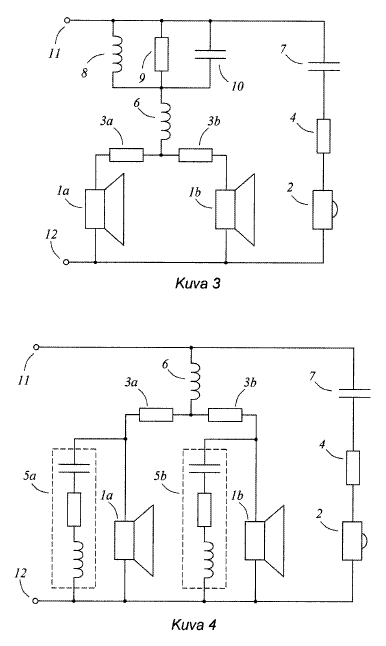Inventions
Patents granted in the UK:
GB2473921 (claiming priority from FI20090354):
Compensation of Rising Frequency Response in Passive Current-Driven Loudspeakers
ABSTRACT:
The sound quality of electro-dynamic loudspeakers can be very much improved by feeding the speaker drivers with a current signal instead of the conventional voltage signal. Current-mode is achieved, when the source impedance seen by the driver is high compared to the driver's own impedance. The problem is that, under current-drive, the rising frequency response of a typical cone-type speaker cannot be equalized simply by adding an RC-network in parallel with the driver because then the high source impedance is lost. In the presented solution is used a dual voice coil speaker driver together with a current dividing network that disables one of the voice coils at high frequencies, thus producing the required response correction while still preserving relatively high source impedance.
GB2473950 (claiming priority from FI20090353):
Protection Circuit for Current-Driven Loudspeakers
ABSTRACT:
By driving an electro-dynamic loudspeaker with a current signal instead of the conventional voltage signal, one can achieve, in addition to superior sound quality, also better-performing protection against driver overloading. The power protection of a current-driven speaker can be accomplished dynamically and without breaking the operation by connecting, through a rectification bridge 2a-d, a power transistor 5 in parallel with the driver to be protected 1; the control voltage of said power transistor 5 being indicative of the voice coil warming in said driver 1. The voltage to be monitored may yet be filtered before rectification, so that the voltage would better represent the voltage dropped in the voice coil resistance.
Finnish utility model:
"Clean-Current Loudspeaker"
Translation of the first paragraphs:
The invention relates to electrodynamic loudspeakers that are used in sound reproduction equipment to convert electrical audio signals to acoustic sound signals. The subject of the invention is a passive, i.e. no amplifiers inholding, loudspeaker unit that incorporates particular series resistors by which the current flowing through the speaker drivers can be made to follow the applied audio signal much more accurately than in conventional loudspeakers, where the current flowing through the drivers experiences distortion due to the uncontrolled electromotive forces induced in the driver. The loudspeaker unit according to the invention suits for use with conventional, off-the-shelf, voltage-output audio amplifiers, so that a special transconductance amplifier is not needed to control the speaker current. The loss in sensitivity and efficiency caused by the series resistors can be partially compensated by using two or more parallelly operating drivers.
With the loudspeaker unit according to the invention is achieved lower distortion and hence better sound quality compared with known technique. Specific to the invention is that the impedance seen by the speaker drivers is made high by means of series resistors in the manner presented in claim 1.
Some guidelines
The idea enables a good, commercially feasible compromise between sound quality improvement and sound pressure available.
If the series resistor (3a, 3b, 4) of a driver is e.g. 5-fold relative to the driver's nominal impedance, the distortions arising from the EMF-induced currents are in principle reduced to 1/6, that is, 15-16 dB relative to voltage operation. The sound level available from a single driver also becomes decreased by 15-16 dB compared with direct feeding. However, by using two parallelly operating drivers, like in the figures, the on-axis level can be increased by 6 dB, so that the net attenuation remains below 10 dB. Further, by using 4 Ω drivers instead of the more common 8 Ω types, the net attenuation can still be reduced by about 3 dB, as the voltage sensitivity of 4 Ω drivers is usually that much higher.


